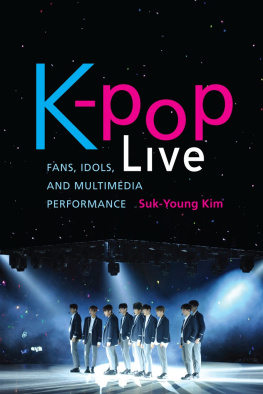Stanford University Press
Stanford, California
2018 by the Board of Trustees of the Leland Stanford Junior University. All rights reserved.
No part of this book may be reproduced or transmitted in any form or by any means, electronic or mechanical, including photocopying and recording, or in any information storage or retrieval system without the prior written permission of Stanford University Press.
Printed in the United States of America on acid-free, archival-quality paper
Library of Congress Cataloging-in-Publication Data
Names: Kim, Suk-Young, 1970 author.
Title: K-pop live : fans, idols, and multimedia performance / Suk-Young Kim.
Description: Stanford, California : Stanford University Press, 2018. | Includes bibliographical references and index.
Identifiers: LCCN 2017050970 | ISBN 9781503605039 (cloth : alk. paper) | ISBN 9781503605992 (pbk. : alk. paper) | ISBN 9781503606005 (epub)
Subjects: LCSH: Popular musicKorea (South)History and criticism. | Popular musicPerformancesKorea (South) | ConcertsKorea (South) | Music and technologyKorea (South)
Classification: LCC ML3502.K6 K577 2018 | DDC 781.63095195dc23
LC record available at https://lccn.loc.gov/2017050970
Typeset by Bruce Lundquist in 10/14 Minion Pro
K-pop Live
FANS, IDOLS, AND MULTIMEDIA PERFORMANCE
Suk-Young Kim
STANFORD UNIVERSITY PRESS
STANFORD, CALIFORNIA
For Miles, the Rising Star
CONTENTS
NOTES ON THE TEXT
1. For transliteration of Korean words, I will consistently use the official Korean-language romanization system released by South Koreas Ministry of Culture and Tourism in 2000, also referred to as Revised Romanization of Korean. Exceptions are made for proper names well known in the English-speaking world by alternate romanizations (e.g., Park Chung-hee rather than Bak Jeong-hui); for authors who have published their names in alternate romanizations (e.g., Kim Suk-Young rather than Gim Suk-yeong); and for performers who deliberately use alternate romanizations for their names (e.g., Lee Hi rather than Yi Ha-i). In the case of these exceptions, the Official Romanization of Korean appears in parentheses after the first occurrence of the term.
2. For East Asian names, surnames precede given names according to the convention of the home country; hence East Asian names appear with the surname first (e.g., Lee Su-man, not Su-man Lee; Ueno Toshiya, not Toshiya Ueno).
3. For the combination of Anglicized first names and Korean last names, the first and the second rules do not apply (e.g., Edward Kang rather than Gang Edward).
4. K-pop band names like BIGBANG or SHINee are mostly left in their own Anglicized spellings, since the groups deliberately use idiosyncratic spellings for professional purposes and are known as such in both Korean and international media.
5. All translations not otherwise credited are my own.
6. When quoting others work, I use the transliteration system originally chosen by other authors.
INTRODUCTION
I know everything is called live now, which really just means we were all alive when we taped it.
Bill Maher, Bill Maher Reflects on Humor, Politics in Wild Election
LOS ANGELES is a city with a thousand faces, a mirage of fragmented impressions, chromatic shades, and sound bites. A major hub where multicultural flows converge, it is a must-stop destination for touring bands from the other side of the Pacific.
EXO, the it band of todays K-pop world, is no exception. They performed at the Los Angeles Sports Arena on February 14, 2016, to a nearly sold-out crowd. The arena, with roughly sixteen thousand seats, was overheated with zealous fans hours before the concert began, to the point that at least two audience members in the standing area were carried out on stretchers even before the band appeared on stage. The body heat emanating from sweltering fans and the screams of excitement from the audience provided undeniable proof that I was indeed at a live event, breathing the same air with pop stars whose natural habitat nowadays happens to be two-dimensional pixel screens of TVs, laptops, and cell phones.
K-pop as a cultural phenomenon started to gain momentum around the turn of the millennium, a time when physical album sales were rapidly collapsing while the online music market was still evolving and maturing. The growth of the digital online music market around this time was impeded by prevalent practices of piracy and illegal downloading, which presented serious challenges to artists who had been sustaining their careers through traditional revenue sources, such as CD sales. That model was vanishing for them, while the market for live shows and multicity tours in Korea and overseas was almost nonexistent.
With this process came the reinvention of K-pop artists, who transformed themselves from mere singers to all-around entertainers whose primary career goal was to gain popularity by excelling in all aspects of media performance, such as singing, dancing, being a charming guest on variety shows, and always presenting an attractive public persona, all under the constant scrutiny of the mediatized world.
So if K-pops ecosystem is the digital media environment, why does this book begin with a scene from a live concert? Why does the main title place live after K-pop, suggesting that the concept of live and its abstraction, liveness, will be the main critical focus?
To be sure, there is evidence that the K-pop industry nowadays is witnessing steady growth in live performances, which could potentially challenge the assumption that K-pops natural habitat is online. For instance, the highly successful K-pop band BIGBANGs Made tour in 201516 ranked as one of the top-ten-grossing tours in the United States in 2015; during the first half of the 2016, BIGBANG became the band to attract the most live concert attendees in Japan, the second-largest music market in the world.
But the books primary inquiry into K-pops liveness is not driven merely by the data showing an increasing number of live K-pop concerts. The book is mainly concerned with a more theoretical investigation of liveness as a technological, ideological, and affective mode in which human subjects interact with other human and nonhuman subjects in the digital age. We live in an era where it is extremely difficult to be engaged in a social relationship unmediated by digital technology, whether texting, video chat, or immersion in virtual reality; in this heavily mediatized environment, the question of what is live becomes a question of how we live our lives as increasingly mediated subjectsfragmented and isolated by technological wonders while also yearning for a sense of belonging and aliveness through an interactive mode of exchange that we often call live. Predominantly conceived as digital music but constantly courting the idea of live performance, K-pop is a prime medium to unfold this paradox.
I had eagerly anticipated the EXO live concert, but as it progressed, my sense of the immediacy of being there gradually turned into frustration. I had to squint in order to discern through the dense crowd the minuscule bodies of eight performers on stage, all of whom appeared no larger than Tinker Bell from the loge where I was seated (promise of a live event that was supposed to guarantee the experience of intimacy and copresence. But just as my frustration began to mount, the stage curtain was transformed into a large screen surface for digital projection; as the live performers were taking a break from their strenuous dance routine, magnified faces of the stars started to appear on the screen as if to compensate for the spectatorial limitations of audience members seated far away from the stage. One by one, each member of the band directed his amorous gaze at the camera, looking directly into the eyes of the viewers, whose point of view had became entirely conflated with that of the person behind the camera. Each band member reached out his hand to hold the hand of the cinematographer-cum-audience, transforming a 2-D video screen into an affective interface where thousands of anonymous concert attendees suddenly became positioned as intimate subjects who could touch and interact with these stars.




![Nietzsche - Twilight of the Idols [N.F. - Philosophy]](/uploads/posts/book/249935/thumbs/nietzsche-twilight-of-the-idols-n-f.jpg)







